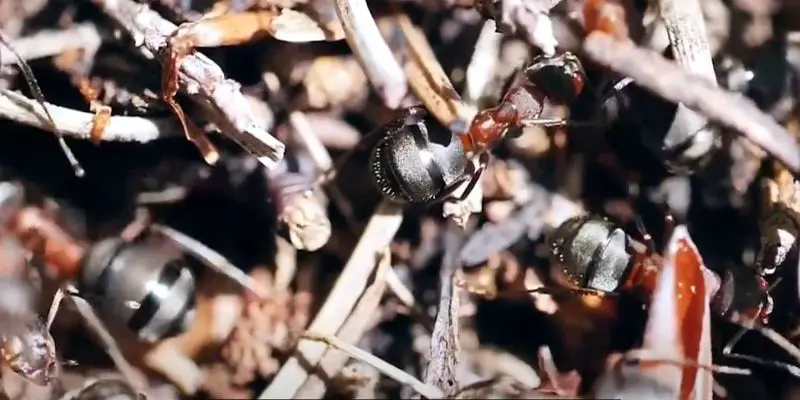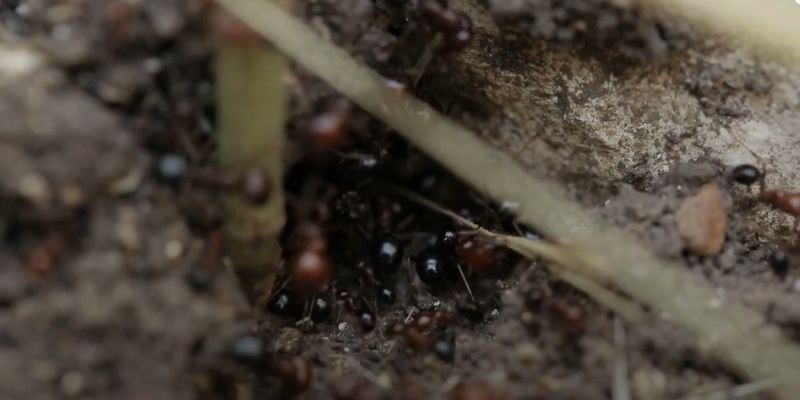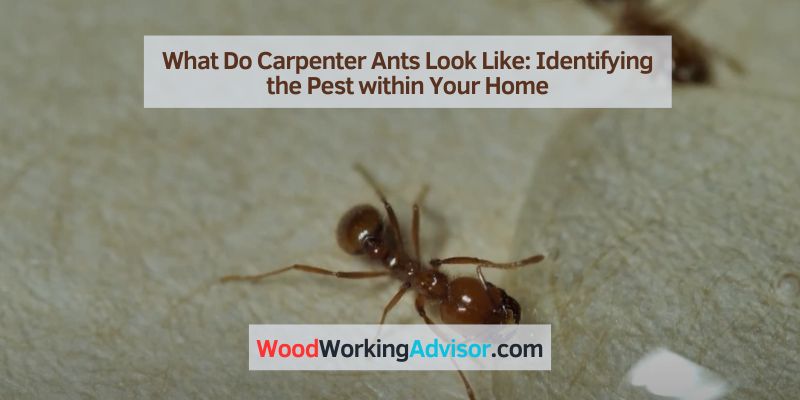Carpenter ants are large, black or red ants. They can grow up to half an inch.
Carpenter ants are easily noticeable due to their large size and distinctive colors. These insects can be black or red, and they often reach up to half an inch in length. They have a segmented body with a narrow waist, and their front wings are longer than the back ones.
With their large mandibles and powerful jaws, they are also known for their ability to tunnel through wood. Identifying carpenter ants early is crucial for preventing potential structural damage to homes, as they are often associated with wood destruction. If you suspect a carpenter ant infestation, it’s important to address the issue promptly to avoid costly repairs.
Carpenter Ant Identification Guide
Carpenter ants are pesky pests that can cause significant damage to wooden structures. Identifying them is crucial for effective pest control. Here’s a carpenter ant identification guide to help you recognize these destructive insects.
Key Characteristics Of Carpenter Ants
Carpenter ants can be identified by several key characteristics:
- Antennae: They have distinctly elbowed antennae.
- Waist: Their waist is constricted, distinguishing them from other ant species.
- Mandibles: They have strong mandibles for chewing through wood.
Size, Color, And Physical Features
When it comes to size, color, and physical features, carpenter ants exhibit the following:
- Size: Carpenter ants can vary in size, with workers typically measuring between 6 to 13 mm in length.
- Color: They are usually black, red, or a combination of both. Some species may have a reddish or yellowish hue.
- Physical Features: Their thorax is evenly rounded, and the front wings are larger than the hind wings.
Variations Among Species
There are several species of carpenter ants, and they may exhibit variations in appearance:
- Camponotus pennsylvanicus: Commonly known as the black carpenter ant, it is entirely black in color.
- Camponotus modoc: This species can vary in color, ranging from yellowish-red to black.
- Camponotus herculeanus: Known as the western carpenter ant, it has a reddish-brown head and thorax, with a black abdomen.
Spotting The Carpenter Ant: Visual Clues
Identifying carpenter ants is crucial for effective pest control as these destructive insects can cause significant damage to wooden structures. Visual clues can help discern carpenter ants from other ant species. Here are the key visual characteristics to look for:
Antennae Shape And Segmentation
Carpenter ants have bent or elbowed antennae with 12 segments, distinguishing them from other ants. Their antennae are vital sensory organs used for communication and navigation. The unique bent shape and segmentation make them easily recognizable.
Body Segmentation And Texture
Examination of the carpenter ant’s body can reveal distinct segments and textures. Unlike termites, carpenter ants have a constricted waist and elbowed antennae, while their thorax is evenly convex. Their thorax, abdomen, and head exhibit noticeable variation in texture, with the thorax being smooth and shiny, while the rest of the body has a finely-ridged appearance. These distinctive features enable differentiation from other ants and wood-destroying insects such as termites.
Winged Carpenter Ants Vs. Other Ants
One distinguishing characteristic of carpenter ants is the presence of winged individuals within the colony. These individuals, known as alates, are reproductive members of the ant colony. When compared to other winged ants, carpenter ant alates have a larger size and are typically black in color. Identifying these winged forms is essential for early detection of carpenter ant infestations.

What Do Carpenter Ants Look Like: Home Intruders
What Do Carpenter Ants Look Like: Home Intruders
When it comes to household pests, carpenter ants are among the most destructive. These large ants can cause significant damage to the wooden structures in your home. Understanding what carpenter ants look like and where they typically reside can help you identify and address an infestation before it becomes a serious problem.
Typical Habitats Inside Your Home
Carpenter ants prefer damp, decaying wood for nesting, so they are commonly found in areas such as:
- Attics
- Basements
- Crawl spaces
- Moisture-prone areas in the kitchen or bathroom
Warning Signs Of An Infestation
Identifying the presence of carpenter ants early can help prevent extensive damage. Look out for these warning signs:
- Piles of sawdust-like material, known as frass, near wooden structures
- Rustling sounds coming from within walls or woodwork
- Visible ants, especially large, winged individuals known as swarmers
- Wood that sounds hollow when tapped
Common Areas To Inspect
When inspecting your home for carpenter ants, pay close attention to the following areas:
- Roof eaves and gutters
- Window and door frames
- Structural wood supports
- Moldings and trim
Differentiating Ants In Your Home
When it comes to identifying ants in your home, it’s important to differentiate between carpenter ants and other common household ants. While many ants may look similar at first glance, understanding the specific characteristics of carpenter ants can help in accurate identification.
Carpenter ants can be distinguished from other ants by observing their behavior. Unlike most ants, carpenter ants do not consume wood but rather excavate it to build nests. They are nocturnal in nature and are often found foraging for food in the evening. Additionally, carpenter ants are skilled climbers and can often be spotted on trees or structures near homes.
When inspecting for carpenter ants, it’s crucial to keep an eye out for specific signs of damage. Unlike termites that consume wood from the inside out, carpenter ants create smooth tunnels within wood, leaving behind sawdust-like frass. Look for areas where wood has been hollowed out and check for piles of frass around your home, which are indicative of carpenter ant activity.
Safeguarding Your Home Against Carpenter Ants
When it comes to safeguarding your home against carpenter ants, it’s crucial to understand what these destructive pests look like and how to prevent them from infesting your property. Carpenter ants are often mistaken for termites due to their similar appearance, but they can cause significant damage to wooden structures if left unchecked.
Preventative Measures To Deter Carpenter Ants
To prevent carpenter ants from invading your home, sealing all cracks and crevices in the foundation and exterior walls is essential. Regularly removing any decaying wood or moist areas near your property can also help deter these pests. Additionally, keeping food tightly sealed and stored properly is crucial in deterring carpenter ants from entering your home in search of sustenance.
Natural Deterrents And Their Effectiveness
Natural deterrents such as diatomaceous earth, borax, and essential oil sprays can be effective in deterring carpenter ants. These natural remedies are non-toxic to humans and pets and can effectively repel ants from entering your home. Peppermint and citrus essential oils are particularly known for their ability to repel ants and can be used as a natural deterrent.
When To Seek Professional Pest Control Services
If you notice a significant carpenter ant infestation or if your preventive measures are not effective in deterring these pests, it’s crucial to seek professional pest control services. Professional pest control experts can accurately assess the extent of the infestation and apply targeted treatments to eradicate carpenter ants from your property.

Frequently Asked Questions On What Do Carpenter Ants Look Like
How Do I Know If It’s A Carpenter Ant?
Carpenter ants are typically larger than other ant species, measuring between ¼ and ½ inch. They have a single node between their abdomen and thorax and feature a round, evenly shaped thorax. They also have large mandibles.
How Do You Get Rid Of Carpenter Ants?
To get rid of carpenter ants, locate and eliminate their nests, seal any entry points, and keep your home clean and dry. Use bait and non-repellent insecticides for effective control. Regular inspections and maintenance will help prevent infestations.
What Attracts Carpenter Ants In A Home?
Carpenter ants are attracted to moisture and decaying wood in homes. Leaking pipes and damp areas are common attractants. Food sources such as sugary substances can also draw them in. Regularly inspecting for and repairing moisture issues can help prevent infestations.
What Bug Is Mistaken For A Carpenter Ant?
A termite is often mistaken for a carpenter ant due to similar appearance and behavior.
Conclusion
In a nutshell, understanding what carpenter ants look like is crucial for effective identification and control. These ants boast a large size and vary in color from black to red. Identifying their distinctive features will enable you to take appropriate measures to prevent infestations and protect your property from potential damage.


